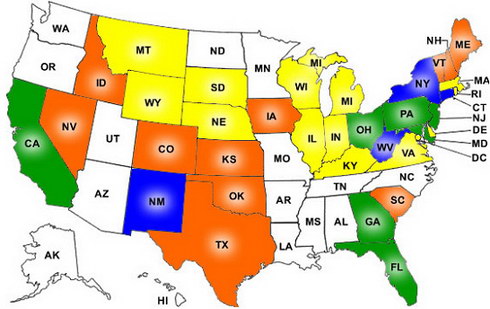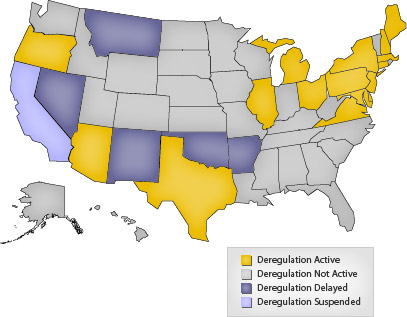|
The Recent History of Natural Gas Deregulation
The structure of the natural gas industry has changed dramatically over the past 20-25 years. Prior to that time, the industry structure was simple, with limited flexibility and few options for natural gas delivery. Exploration and Production companies explored and drilled for the gas, and sold it at the wellhead to large transportation pipelines. The pipelines then transported gas to a local distribution company (LDC), who distributed and sold gas directly to end users. Essentially, the supply, transmission and distribution of natural gas was handled by local utility companies.
The relatively low rates for natural gas set in the early 50's were well below the market value, and demand surged over the next two decades. Unfortunately, gas companies weren't inclined to search for additional gas reserves due to the low selling price of natural gas. The eventual supply shortages led Congress to legislate the Natural Gas Policy Act in 1978.
The gradual climb toward deregulation began with the Natural Gas Policy Act, and the removal of price ceilings at the gas supply's source—the wellhead.
Since then, due to a number of regulatory changes mandated by the Federal Energy Regulatory Commission (FERC), the market has significantly changed and is much more open to competition and choice. As of January 1, 1993, price regulations at the wellhead were eliminated. Customers are now able to choose who supplies their natural gas, but the transmission and distribution of natural gas is still regulated, meaning the price for these two services are maintained and set by both state and federal tariffs.
What This Means for You - the Consumer
Thankfully, natural gas marketers are providing several options in either bundled or unbundled packages, meaning you have plenty of options when it comes to product and pricing. Bundled packages were the standard before deregulation allowed an LDC to sell natural with all applicable sales, storage, transmission, delivery and any additional fees separately. Prior to deregulation, the consumer paid for all fees together, giving little wiggle room in pricing.
Map of Natural Gas Deregulated States

|
These states have fully implemented a competitive natural gas market and all non-residential customers are eligible for customer choice.
|
|
These states have begun implementing a competitive natural gas market.
|
|
These states have either established a timeline for implementing restructuring, or are offering pilot programs for some customers. |
|
These states are currently pursuing legislation, regulations, or programs to implement natural gas restructuring. |
|
In these states, unbundled service is only available to large commercial and industrial customers. Unbundled service is available for large commercial and industrial customers in every state. Restructuring for small commercial and residential customers is varied throughout the states. |
*Map from LPB Energy Consulting
Electricity Deregulation:
What it is and What it Means to You?
The deregulation of electricity presents an unprecedented opportunity for many consumers to save money. When a state deregulates its electricity market, the electricity supply component is separated from the transmission, distribution, servicing, and administration of electricity. This opens up a state market to competition for the sale of electricity.
Before deregulation monopolistic electricity utilities performed all of the basic functions: generation, transmission, distribution, servicing, and administration.
- Generation, the component being deregulated, is the actual production and sale of electricity at a power plant using coal, gas, oil, wind, water, or nuclear power. The expense of generating electricity is dependent upon fuel, operation, and plant maintenance costs.
- Transmission is the delivery of electricity from the generating power plant to the substations within a single utility’s network or to multiple systems involving several utilities. The owners of transmission facilities charge others for the use of their lines.
- Distribution, is the delivery of electricity from substation to consumer, and includes the servicing and administration functions of individual customer meter reading, billing, connection to the electric system, and repair of local electricity lines.
Deregulation of electricity began in the early 1990's with the passage of federal legislation including the Energy Policy Act (EPAct H.R 776). This act established federal guidelines mandating fair access to transmission networks and initiated a competitive market at the wholesale level, which included large industrial accounts and municipal users. This was followed by open access to the wire system delivering electricity to commercial and residential markets. This is referred to as deregulation at the retail level. Today, electricity deregulation is being implemented on a state-by-state basis for commercial, industrial, and residential customers.
As a result, consumers in a growing number of states can seek the best combination of price, reliability, and customer service. While cost is important, the choice of supplier is critical. Ultimately, a supplier’s ability to live up to its promises will prove only as good as its technology, resources, and ability to compete with other electricity management companies.
Utility companies that continue to provide all services must vie for position in a market that is increasingly competitive on a component level. A number of companies may only generate electric power effectively. Some utilities have sold their generating plants while others are buying plants in regions outside of their local operating areas. Still others may wish to concentrate on well-maintained and efficiently operated distribution systems.
Another issue of concern for consumers is “stranded costs”, one of the main reasons many states delay deregulation. These expenses represent the initial costs incurred by utilities in building their infrastructure of power generating plants, transmission lines, and distribution systems to support future customer service. Often, in order to recoup a portion of their investments, under deregulation utilities negotiate with state public utility commissions the ability to charge all customers in their service territory a prorated share of the stranded costs over a period of time. This surcharge, which may effectively negate any savings from competition, is reflected in the individual customer's bill, regardless of which company ultimately supplies the customer electricity.
Therefore, in order to make an informed favorable business decision in a deregulated electricity market, customers must understand and weigh many factors including the price of electricity, reliability of suppliers, associated fees such as stranded costs, customer service, and supplier experience. Consumers in deregulated states who do not choose an electricity supplier will “default” to their current local utility and pay a predetermined rate and may miss substantial savings opportunities.
To obtain a rate lower than the default rate available from utilities and more information on reducing electricity and other utility costs contact us at 800-893-1072 or Vinnie@MyUtilityChoice.com.
Map of Electricity Deregulated States

Energy deregulation is spreading throughout the country and won't it be great to have a team in place when we open the market up in your home state.
|